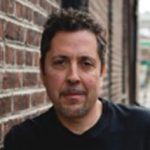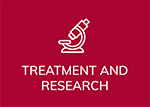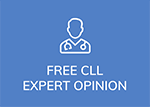
By Glenn Sabin – Patient
In the fall of 1991, at the age of 28, a routine physical with my primary care physician swiftly changed from its predictable pattern and transformed into a shocking diagnosis of Chronic Lymphocytic Leukemia (CLL).
I was given a dire prognosis: six months to live.
Bruce R. Kressel, MD, a Washington, DC based hematologist, now associated with the Johns Hopkins system, would soon confirm the CLL diagnosis via bone marrow biopsy.
Apparently I’d had the disease for some time; my spleen was significantly enlarged. A normal spleen weighs about two-and-a-half pounds. Mine was seven—infiltrated by five pounds of leukemic cells. Two months later, I underwent a splenectomy to de-bulk the tumor burden.
Prognosis and Treatment Options
After recovering from the splenectomy, I sat down with my hematologist to discuss my prognosis and options for treatment. Given my age, he suggested I obtain a second opinion from a major cancer center. It was arranged and carried out with Lee M. Nadler, MD, a leading CLL clinician investigator at Harvard’s Dana-Farber Cancer Institute.
I was offered two choices: watchful waiting or bone marrow transplant.
1991 had ushered in a shift in the standard of care from an immediate cocktail of chemotherapeutics to the option of watchful waiting—basically observing the course of disease. The theory was, when the disease made a more aggressive move, it would then receive a violent assault in the form of multiple chemotherapy agents and steroids.
At that time, bone marrow transplants were essentially experimental as potentially curative intervention, carrying with it the risk associated with graft versus host disease—and a 20% mortality rate. My siblings had their blood tested for matching purposes, but since none matched, allogeneic transplant was ruled out. For reasons I do not recall, we never looked at the marrow registry.
That left the option of an autologous bone marrow transplant—removing some affected marrow with biopsy needles, after which my entire immune system would be wiped out with high dose chemo and radiation therapy; my marrow would be eliminated; I would be isolated for an extended period of time, then, once the marrow was destroyed, my own ‘cleaned’ marrow would be reintroduced into my system and further stimulated to repopulate. Furthermore, I would be rendered sterile and have to bank sperm if I wanted children.
Hard Choices
CLL is an older person’s disease. I was in my late twenties, newly married—prime of life. I was told my condition was terminal, but that I could live a number of years by managing the disease with various interventions, as needed; a palliative approach.
But how could I, a forward-leaning type-A, get comfortable with the two options? Watchful waiting seemed incredibly passive—essentially a sitting duck. And the bone marrow transplant appeared incredibly invasive. And there was that 20% mortality rate.
Ultimately I chose neither option and went with what I call ‘proactive observation’. I would not simply wait for the other shoe to drop. I would learn what I had to do to become the center of my own healing, playing a meaningful role in the management of disease. After all, I was told that the science of CLL was evolving quickly; apparently new cures were on the horizon. Perhaps I could hold my disease at bay until a curative intervention became available?
Becoming Empowered
I shared my preferred care approach with my esteemed oncology team and asked important questions. What proactive measures could I take to become more involved in my own care? What lifestyle change might positively impact my immune function, or possibly alter the biology of the CLL?
There was unanimity in their response: Nothing I could do would positively affect the course of disease. The leukemia was caused by a genetic malfunction; it was not my fault; diet and exercise would make no difference; I should focus on trying to live the best life I could.
Soon I would understand that my oncology team was not all that interested, or trained, in nutrition and other lifestyle approaches to cancer care. At the time of my diagnosis, the literature was largely void of studies showing the benefit of diet, physical activity, and stress reduction on helping to prevent disease, let alone to control its growth, or to better ensure long-term survivorship.
It was incredibly discouraging that my well-regarded oncology team saw zero value in the behavioral change I planned to investigate. I decided to look for others who could support me.
Earliest Days of Integrative Oncology
My diagnosis, in 1991, came a dozen years before the founding of the Society for Integrative Oncology; a full decade before major cancer centers launched integrative medicine clinical programs. It was early innings, and the pushback within academia, and across the private practice community within oncology, was intense. The terms ‘alternative medicine’, ‘CAM’ and ‘integrative oncology’ were largely conflated by the majority of healthcare professionals.
Suffice it to say, as carefully as I approached the management of my disease, I often felt stranded on a deserted island.
Taking Control
If I was going to create a comprehensive program to affect the biology of my disease—or, at a minimum, supercharge my immune function—I would need to figure it out on my own.
And so began my journey to find sensible, evidence-based approaches to improving my overall health and quality of life. These were pre-Internet days. Libraries and bookstores held books and articles on the biology of CLL, and some pioneering works on the impact of lifestyle changes on disease.
Ross Pelton, RPh, CN, became my first ‘integrative health’ mentor. After reading Ross’s Alternatives in Cancer Therapy, I went to his home in San Diego for a consultation. He taught me various lifestyle approaches to increase my immune function and to create an internal environment less hospitable for cancer growth.
Over time, I would learn about the connection between malignant disease and nutrition, inflammation, oxidative stress, insulin-like growth factor, hydration, metabolism, stress hormones and more.
I became a pescatarian, focusing on a plant rich diet along with cold-water omega-rich fish. My exercise regimen was increased: more frequency and a lot more cardio. I installed a whole-house water filtration system, and I arranged for the drinking water supply at my home and office to be outfitted with reverse osmosis system. I began learning meditation and other forms of stress reduction.
Though I had taken various supplements since I was 17-years-old, Ross provided guidance around a regimen of supplements and fermented soy to which I closely adhered.
I worked with Ross for almost five years, before moving on to another, what I have coined, ‘nutritional pharmacologist’—a pharmacist who is also a clinical nutritionist.
I met Irwin “Irv” Rosenberg, RPh, CN in late 1999. Irv is the co-founder of what is now called Village Green Apothecary, a single-location sprawling ‘compounding pharmacy’ located across the street from The National Institutes of Health in Bethesda, Maryland. Irv reviewed my protocol and made several recommendations to fortify my program.
Irv invested significant time reviewing the literature for scores of natural products showing anticancer activity. He had relationships with all of the major pharma-grade supplement brands and a finger on the pulse of dietary supplement products and development pipeline. It would take a couple of months to review and understand all of the changes Irv recommended, and put those into place in early 2000.
Becoming Sicker
Though my bone marrow had steadily become more involved with leukemic cells, my blood counts were stable and I felt quite well. I was living a full and active life.
That would change in the summer of 2003, a dozen years after my diagnosis. I became ill with a coombs positive hemolytic anemia. My hematocrit dipped to 22. My bone marrow was now infiltrated by over ninety percent leukemic cells, crowding out remaining healthy cells.
I made clinic appointments with my local oncologist, Dr. Kressel, MD, and the CLL specialists at Hopkins’ Sidney Kimmel Cancer Center in Baltimore. From there I went to Harvard for an appointment with Dr. Nadler at Dana-Farber.
The consensus was clear among my oncology team: I needed to be treated. Immediately. The standard of care had evolved some, and featured the promising new monoclonal-antibody Rituximab, in addition to a couple of chemotherapeutic agents and prednisone.
An autologous bone marrow transplant was no longer offered. Unfortunately, it had not been the curative intervention that people had hoped for. Everyone who had an autologous transplant for CLL would relapse.
The experts pushed for therapy to start within a week. Dr. Nadler’s words echoed in my head: “Glenn, you are heading over the top of the cliff; you need to be treated. Now”
In truth, I felt horrible. I had a constant low-grade fever, was incredibly weak, and woke drenched in a cold sweat three or four times each night. My quality of life was disintegrating. I had a hard time focusing. I needed relief.
Extending the Experiment
I told my physicians that I would not submit to conventional therapy. At least not immediately.
This decision was based on one simple fact: CLL was still considered incurable. The cocktail of monoclonal-antibody, chemo, and prednisone was essentially a palliative intervention—a Band-Aid until future treatment. It might put me into a partial remission for a year or two, but the leukemia was certain to return. And at that point it would most likely be resistant to the same drug therapy. I was also aware of the potential, lifelong side effects associated with the recommended schema.
I was now a dozen years into my healing experiment. Though I had an underlying severe auto-immune hemolytic anemia (AIHA), and a blood chemistry gone awry, my body was well-conditioned from my extensive integrative oncology regimen.
What are the limits of the body’s innate capacity to heal? Could I possibly positively affect my immune function to change the course of this acute situation?
I told my physicians that while I was not refusing conventional intervention categorically, we would work together over the coming weeks and monitor my blood. If I was unable to impact the course of the AIHA, I would agree to treatment.
My oncologists clearly felt I was wasting my time with this approach. However, I had nothing to lose; the standard of care was not curative. But it could deliver relief from my intense suffering. Still, I understood the relationship between my blood chemistry and my feelings well enough to hold off. I trusted that I’d know if and when to nod to that course of treatment.
Sabbatical and Revised Regimen
I took a sabbatical from the media company I was running, addressing only the most critical aspects of the business decision-making process. I then revisited my nutraceutical protocol with Irv Rosenberg, eliminating some agents and adding others, such as CLA, artemisinim, and a whey-based immunoglobulin product.
Though my anemia was severe, and I was warned about the strain it was having on my heart, I continued with my daily cardio routine of walking and swimming. The activity was short, but happened every day, all outside. It was during these walks and swims that I felt most relaxed. For me, this was the most powerful form of mind/body work. I am simply not the type to sit still and meditate. I tried that early on, and struggled to ‘turn off the noise’.
Achieving First Clinical Response
Complete blood counts were being done a couple times each week. After several weeks my counts stabilized. After 30 days, there was a clear trend showing improvement. After a couple months the CBC showed that my blood chemistry had completely normalized.
With that news, I had a flow cytometry done locally in order to take a deeper look at the blood. From a systemic view, there was no evidence of disease.
Some months later, as my full strength returned and I returned to working my previous, regular schedule, I went up to Harvard for a PET/CT scan, additional diagnostics, and a physical exam. All confirmed no evidence of disease.
I had achieved a partial remission without conventional treatment of any kind. While the systemic blood was clear of leukemia, a bone marrow biopsy revealed my marrow was still impacted by leukemic cells, though greatly reduced since my acute episode.
(NOTE: I would later learn that I am the only case in the medical literature showing reversal of AIHA without the aid of steroids or other drug agents.)
Relapse
I remained in good health and in a partial remission status for six years, until 2009, when the disease recurred.
My white blood cells starting increasing; I was anemic, and my absolute lymphocyte count began to rise.
From a psychological standpoint it was a challenging period. But I was able to separate the emotional impact from how I was doing physically: asymptomatic and feeling perfectly well.
I would approach this news as I had dealt with my illness over many years. I revisited the current standard of care, which had virtually remained static since 2003. I reviewed every aspect of my protocol. I honestly reflected on the current amount of stress in my life.
Earlier, in the summer of 2009, I’d heard a lecture by Keith I. Block, MD and Penny B. Block, PhD. Thoroughly impressed by the presentation, I read Dr. Block’s book, Life Over Cancer. Within weeks I was at the Block Center for Integrative Cancer Treatment in Evanston, Illinois (since relocated to Skokie).
At that point I was not ‘sick’, but had a growing interest in research models. Specifically, I was interested in exploring non-reductive whole systems integrative oncology clinical study designs. There was interest at Harvard, and other institutes, to explore a program for CLL, and I felt that bringing in Drs. Keith and Penny Block to collaborate would be a terrific complement for the type of study I envisioned.
Later that year, when I relapsed, I didn’t have to give much thought about who I would turn to for help. It was at that point, in the fall of 2009, that I started working with Dr. Block as his patient. He would become my first integrative physician since the onset of my disease 18 years earlier.
Recalibrating the Investigation
Dr. Block and his team suggested significant changes to my nutraceutical regimen. And, unlike my work with Ross Pelton and Irv Rosenberg, the recommendations Dr. Block made were scientifically informed by my unique biochemical milieu—based on my macro and micronutrient levels, and various biomarkers connected to hormones, glucose panels, inflammatory load, circulation, and oxidative stress levels.
I adhered to the new supplement protocol for a number of months, but my white blood count continued to elevate, exceeding 50,000. Ten months into the new protocol, additional changes were made that included clinical dosing of green tea extract (EGCG). We followed the Mayo Clinic dosing of 4 grams daily, which was tolerated well in a phase I study.
Achieving Second Clinical Response—Complete Remission
After the green tea extract was added, over a relatively short period of time, my white blood counts stabilized. Soon, all areas of my blood chemistry normalized. Flow cytometry showed NED in my systemic bloodstream. I had achieved a second clinical response without conventional intervention.
In January 2012, I returned to see Dr. Nadler in clinic at Dana-Farber. Although not clinically indicated, I insisted on a bone marrow biopsy. From a scientific standpoint it was well-indicated, and, again, I was quite curious if my actions had had any measurable impact on the marrow.
The pathology came back with the following note:
“Flow cytometric studies of bone marrow and peripheral blood do not reveal diagnostic features of involvement by a lymphoproliferative disorder”.
There was no evidence of disease by phenotype or morphology. A Harvard pathologist could not tell that I ever had CLL.
In January 2014, I repeated a bone marrow biopsy that showed I was in a complete, durable remission.
I make no claims as to how this complete remission was achieved. I applied a comprehensive, bio-synergistic approach to my disease for over two decades. My outcome does not prove causation.
I do not speculate on pathways, because I do not find it a useful practice. Was it modulation of gene expression, apoptosis, a sustained cytotoxic-like affect from clinical dosing of agents such as EGCG and turmeric? Did the cells simply normalize on their own? I will never know.
Furthermore, for this article, I have chosen not to share specificity of natural agents, dosing, and how they were informed. It’s not been my intention to be prescriptive, but to share my journey purely from a patient’s perspective. Mine is a story of empowerment and self-efficacy, with a simple message: we are each an n of 1.
Click here to download an excerpt from Glenn’s book, n of 1, plus receive a bonus guide: 10 Essential Steps to Take Control of Your Cancer Journey.
For more details on Glenn Sabin’s clinical case, a peer-reviewed case report was published in December 2015 in Cureus. https://glennsabin.com/wp-content/uploads/2016/01/Glenn_Sabin_Cureus_case_report.pdf
Glenn Sabin lives in the Washington, D.C. area with his wife Linda, sons Miles and Jared, and mini schnauzer Leo. He is founder of FON Consulting, a business development firm dedicated to advancing integrative medicine as the new standard of care. Sabin writes and speaks about integrative medicine and cancer prevention.
Originally published in The CLL Tribune Q3 2017.

















